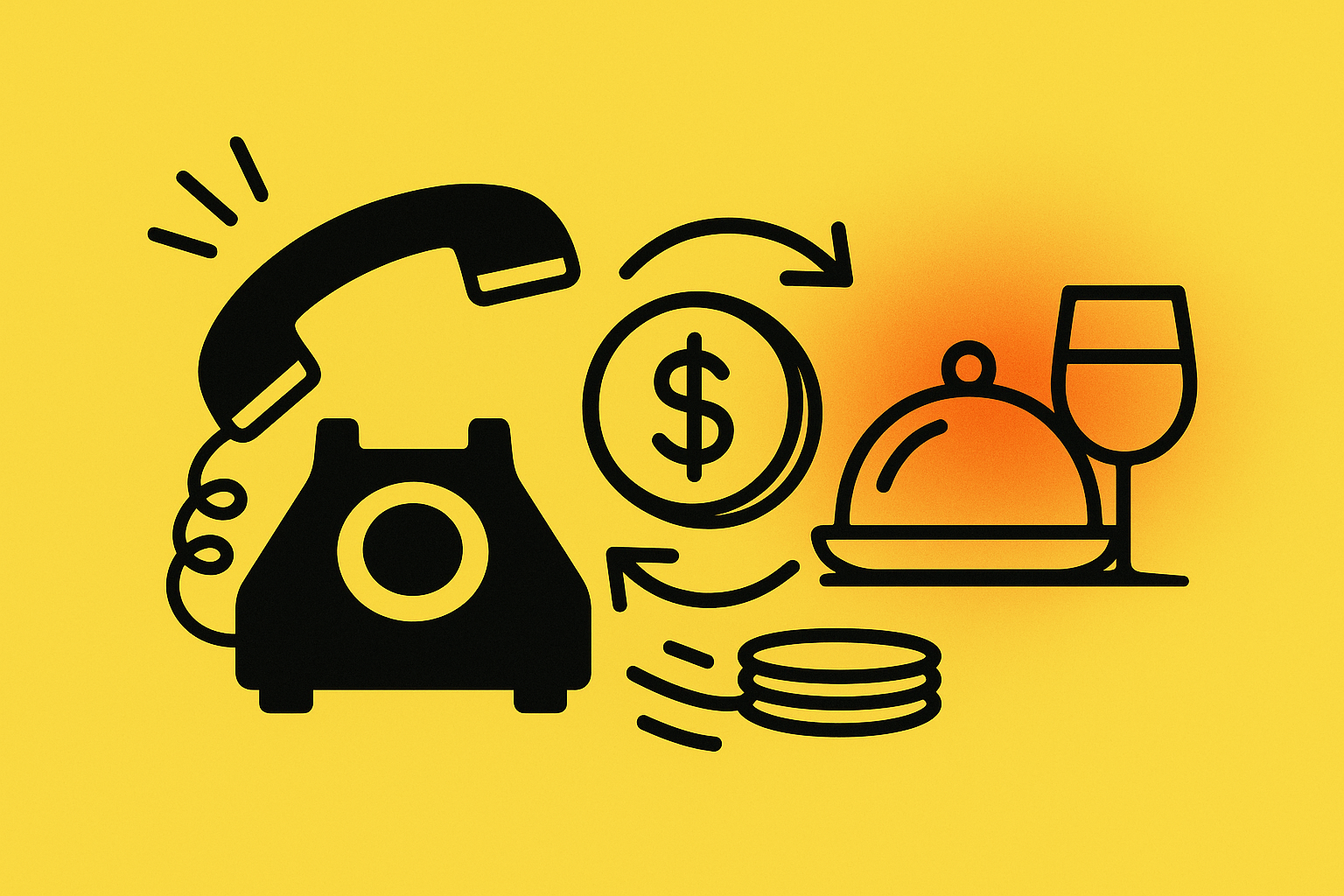
Every unanswered phone call at your restaurant is money walking out the door. With DoorDash data showing 50% of restaurant calls still go unanswered and tourist markets seeing 800-1,000 calls per month, the revenue leak is quantifiable and massive. (Hostie AI Blog)
The numbers are staggering: 63% of Americans say calling is their preferred way to contact a restaurant, yet over two-thirds would ditch restaurants that don't answer the phone. (Hostie AI Blog) This disconnect between customer preference and operational reality creates a perfect storm of lost revenue that AI-powered solutions like Hostie AI are uniquely positioned to solve.
In this comprehensive ROI analysis, we'll build a step-by-step calculator that factors call volume, average check size, and conversion uplift to show exactly how AI phone systems generate $3,000 to $18,000 per month per location. (Q3 2025 Restaurant Tech Trends) We'll validate our model against real-world deployments and provide you with a downloadable template to calculate your own break-even timeline.
Restaurant operators often underestimate the true cost of missed calls because the loss is invisible. Unlike a dine-and-dash or inventory shrinkage, you can't see the customers who called, got no answer, and ordered from your competitor instead.
Here's what the data reveals:
Let's do the math on a typical casual-dining location:
That's over $123,000 annually from a single location, just from missed phone calls.
Most restaurants try to solve this with more staff or better training, but these approaches have fundamental limitations:
Staff-based solutions:
Training-focused approaches:
This is where AI-powered solutions like Hostie AI fundamentally change the equation. After integrating with partner establishments such as Flour + Water and Slanted Door, Hostie now handles over 80% of their guest communications automatically. (Hostie AI Blog)
Before calculating ROI, you need accurate baseline metrics. Most restaurants underestimate their actual call volume because they only count answered calls.
Data Collection Method:
Typical Call Volume by Restaurant Type:
| Restaurant Type | Monthly Calls | Peak Hour Calls | Answer Rate |
|---|---|---|---|
| Fast Casual | 400-600 | 15-25 | 70-80% |
| Casual Dining | 600-900 | 25-40 | 50-65% |
| Fine Dining | 300-500 | 10-20 | 80-90% |
| Tourist Markets | 800-1,200 | 40-60 | 40-55% |
Not every call converts to revenue, but understanding your conversion funnel is crucial for accurate ROI projections.
Conversion Funnel Breakdown:
Revenue Calculation Formula:
Monthly Revenue from Calls =
(Reservation Calls × 0.85 × Avg Party Size × Avg Check) +
(Takeout Calls × 0.95 × Avg Takeout Order) +
(Event Calls × 0.25 × Avg Event Revenue)
AI systems like Hostie don't just answer more calls—they optimize the entire customer interaction. Restaurants implementing AI reservation systems with native Toast integration are seeing an average 26% lift in covers. (2025 AI Restaurant Reservation Systems Guide)
Key Performance Improvements:
The Slanted Door Group saw a 56% boost in over-the-phone covers after implementing Hostie AI. (Hostie AI Case Study)
Implementation Costs:
Revenue Benefits:
The Slanted Door Group's implementation provides a perfect case study for ROI validation. After deploying Hostie AI, they achieved:
ROI Calculation for Similar Operations:
Assuming a casual-dining location with:
Before AI Implementation:
After AI Implementation (56% lift):
Net Monthly Gain: $24,310
Annual Revenue Increase: $291,720
ROI: 1,223% (after $199/month AI cost)
Red Lobster's chain-wide rollout of SoundHound's voice ordering system in September 2025 provides additional validation for AI phone systems in casual dining. While specific ROI numbers aren't public, the chain-wide deployment indicates significant positive results from pilot programs.
The global food automation market is projected to reach $14 billion by the end of 2024, with a potential 69% increase in AI and robotics use in fast food restaurants by 2027. (Q3 2025 Restaurant Tech Trends)
Current State Assessment:
Monthly Call Volume: ___________
Current Answer Rate: ___________%
Average Conversion Rate: _______%
Average Check Size: $__________
Average Party Size: ___________
AI Implementation Projections:
Projected Answer Rate: 95%
Projected Conversion Rate: +20% improvement
Projected AOV Increase: +10%
Monthly AI Cost: $199
ROI Calculation:
Current Monthly Revenue =
(Monthly Calls × Answer Rate × Conversion Rate × Party Size × Check Size)
Projected Monthly Revenue =
(Monthly Calls × 0.95 × Improved Conversion × Party Size × Improved Check Size)
Net Monthly Gain = Projected Revenue - Current Revenue - $199
Annual ROI = (Net Monthly Gain × 12) / ($199 × 12) × 100
Most restaurants see positive ROI within 30-60 days of implementation. Here's why:
Month 1: Setup and optimization period
Month 2-3: Full optimization realized
Month 4+: Compound benefits
While direct call revenue is the most measurable benefit, AI phone systems provide additional value that compounds over time:
Operational Efficiency Gains:
Customer Experience Improvements:
Hostie AI integrates directly with existing reservation systems, POS systems, and event planning software, ensuring a seamless experience for both staff and customers. (Hostie AI Blog)
Data and Analytics Value:
For restaurant groups, the ROI multiplies across locations while implementation costs remain relatively fixed:
Single Location ROI: $10,000-15,000 monthly revenue increase
5-Location Group: $50,000-75,000 monthly revenue increase
Implementation Cost: Scales efficiently with volume discounts
The integration process with systems like Toast POS can be completed in under 60 minutes per location, making chain-wide rollouts highly efficient. (Toast POS Integration Guide)
Day 1-3: Baseline Data Collection
Day 4-7: System Integration
Hostie AI allows for integration with OpenTable reservations and Square POS system in under 60 minutes. (OpenTable Square Integration Guide)
Staff Training:
System Optimization:
Performance Monitoring:
Continuous Improvement:
When presenting to ownership or corporate leadership, focus on these key points:
The Problem:
The Solution:
The Investment:
The Return:
Common Concerns and Responses:
"What if customers don't like talking to AI?"
"How do we handle technical issues?"
"What about integration complexity?"
Hostie was created by a restaurant owner and an AI engineer, ensuring deep understanding of operational needs and challenges. (Hostie AI Blog)
The restaurant technology landscape continues evolving rapidly. AI solutions that integrate well with existing systems and adapt to new technologies provide the best long-term value.
Current Integration Capabilities:
Emerging Technology Compatibility:
The momentum behind restaurant AI adoption is accelerating. 57% of hospitality owners worldwide have adopted automation as a critical survival strategy, and 58% of people aged 18-38 are more likely to return to restaurants that use automation. (OpenTable Square Integration Guide)
This trend indicates that AI adoption is moving from competitive advantage to competitive necessity. Early adopters benefit from:
The math is clear: missed calls represent massive revenue leakage that AI-powered solutions can effectively plug. With 63% of Americans preferring to call restaurants and 50% of calls going unanswered, the opportunity is both immediate and substantial. (Hostie AI Blog)
Our ROI calculator demonstrates that restaurants implementing AI phone systems typically see:
The Slanted Door Group's 56% boost in phone-based covers and Hostie AI's track record of handling over 80% of guest communications automatically provide real-world validation of these projections. (Hostie AI Case Study)
As the restaurant industry continues embracing AI solutions—with the global food automation market reaching $14 billion by 2024—early adopters position themselves for sustained competitive advantage. (Q3 2025 Restaurant Tech Trends)
The question isn't whether to implement AI phone systems, but how quickly you can capture the revenue that's currently walking out your door with every missed call. With solutions like Hostie AI starting at just $199 per month and integration possible in under 60 minutes, the barrier to entry has never been lower while the potential returns have never been higher. (Hostie AI Blog)
💡 Ready to see Hostie in action?
Don't miss another reservation or guest call.
👉 Book a demo with Hostie today
AI solutions like Hostie AI are generating an additional revenue of $3,000 to $18,000 per month per location, up to 25 times the cost of the AI host itself. With 50% of restaurant calls going unanswered and tourist markets seeing 800-1,000 calls per month, the revenue potential from capturing missed calls is substantial.
According to DoorDash data, 50% of restaurant calls still go unanswered, representing a massive revenue leak. Over two-thirds of Americans would ditch restaurants that don't answer the phone, making call management critical for customer retention and revenue growth.
Hostie AI can integrate with popular systems like OpenTable reservations and Square POS in under 60 minutes. The platform also offers native Toast POS integration, allowing restaurants implementing AI reservation systems to see an average 26% lift in covers with streamlined operations.
Hostie AI handles over 80% of guest communications automatically for partner establishments like Flour + Water and Slanted Door. The system enables zero-touch reservations where calls flow directly from the AI system to POS and kitchen display systems without human intervention.
With 57% of hospitality owners worldwide adopting automation as a critical survival strategy, AI phone systems address labor gaps and improve guest experience. The global food automation market is projected to reach $14 billion by 2024, with 58% of people aged 18-38 more likely to return to restaurants using automation.
Hostie AI stands out as one of the four leading AI reservation platforms alongside SoundHound, Slang AI, and Axify. What sets Hostie apart is its focus on turning missed calls into revenue opportunities, with proven results at establishments like Flour + Water and comprehensive POS integrations for seamless operations.
RELATED


